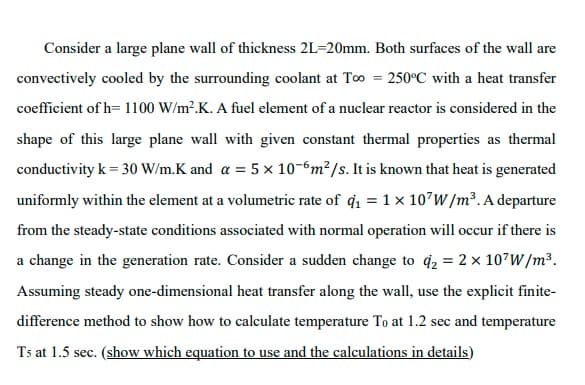Consider a large plane wall of thickness 2L=20mm. Both surfaces of the wall are convectively cooled by the surrounding coolant at Too = 250°C with a heat transfer coefficient of h= 1100 W/m³.K. A fuel element of a nuclear reactor is considered in the shape of this large plane wall with given constant thermal properties as thermal conductivity k = 30 W/m.K and a = 5 x 10-6m²/s. It is known that heat is generated uniformly within the element at a volumetric rate of q = 1x 107W/m³. A departure from the steady-state conditions associated with normal operation will occur if there is a change in the generation rate. Consider a sudden change to d2 = 2 × 107W /m³. Assuming steady one-dimensional heat transfer along the wall, use the explicit finite- difference method to show how to calculate temperature To at 1.2 sec and temperature Ts at 1.5 sec. (show which equation to use and the calculations in details)
Consider a large plane wall of thickness 2L=20mm. Both surfaces of the wall are convectively cooled by the surrounding coolant at Too = 250°C with a heat transfer coefficient of h= 1100 W/m³.K. A fuel element of a nuclear reactor is considered in the shape of this large plane wall with given constant thermal properties as thermal conductivity k = 30 W/m.K and a = 5 x 10-6m²/s. It is known that heat is generated uniformly within the element at a volumetric rate of q = 1x 107W/m³. A departure from the steady-state conditions associated with normal operation will occur if there is a change in the generation rate. Consider a sudden change to d2 = 2 × 107W /m³. Assuming steady one-dimensional heat transfer along the wall, use the explicit finite- difference method to show how to calculate temperature To at 1.2 sec and temperature Ts at 1.5 sec. (show which equation to use and the calculations in details)
Principles of Heat Transfer (Activate Learning with these NEW titles from Engineering!)
8th Edition
ISBN:9781305387102
Author:Kreith, Frank; Manglik, Raj M.
Publisher:Kreith, Frank; Manglik, Raj M.
Chapter2: Steady Heat Conduction
Section: Chapter Questions
Problem 2.38P:
2.38 The addition of aluminum fins has been suggested to increase the rate of heat dissipation from...
Related questions
Question

Transcribed Image Text:Consider a large plane wall of thickness 2L=20mm. Both surfaces of the wall are
convectively cooled by the surrounding coolant at To = 250°C with a heat transfer
coefficient of h= 1100 W/m².K. A fuel element of a nuclear reactor is considered in the
shape of this large plane wall with given constant thermal properties as thermal
conductivity k = 30 W/m.K and a = 5 x 10-6m²/s. It is known that heat is generated
uniformly within the element at a volumetric rate of q = 1x 107W /m³. A departure
from the steady-state conditions associated with normal operation will occur if there is
a change in the generation rate. Consider a sudden change to q2 = 2 x 107W/m³.
Assuming steady one-dimensional heat transfer along the wall, use the explicit finite-
difference method to show how to calculate temperature To at 1.2 sec and temperature
Ts at 1.5 sec. (show which equation to use and the calculations in details)
Expert Solution
This question has been solved!
Explore an expertly crafted, step-by-step solution for a thorough understanding of key concepts.
Step by step
Solved in 4 steps

Knowledge Booster
Learn more about
Need a deep-dive on the concept behind this application? Look no further. Learn more about this topic, mechanical-engineering and related others by exploring similar questions and additional content below.Recommended textbooks for you

Principles of Heat Transfer (Activate Learning wi…
Mechanical Engineering
ISBN:
9781305387102
Author:
Kreith, Frank; Manglik, Raj M.
Publisher:
Cengage Learning

Principles of Heat Transfer (Activate Learning wi…
Mechanical Engineering
ISBN:
9781305387102
Author:
Kreith, Frank; Manglik, Raj M.
Publisher:
Cengage Learning